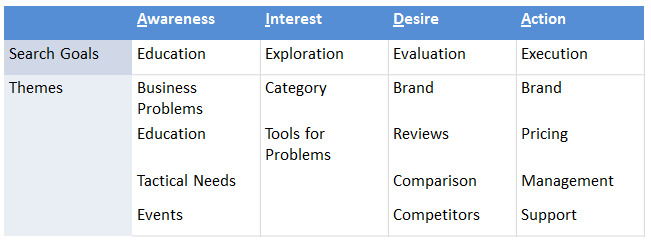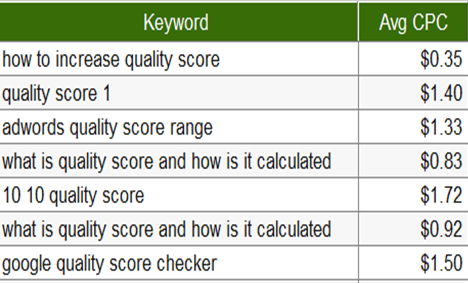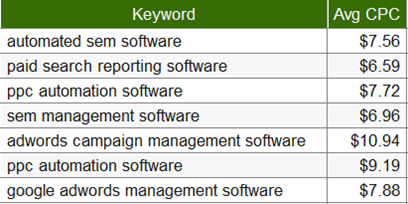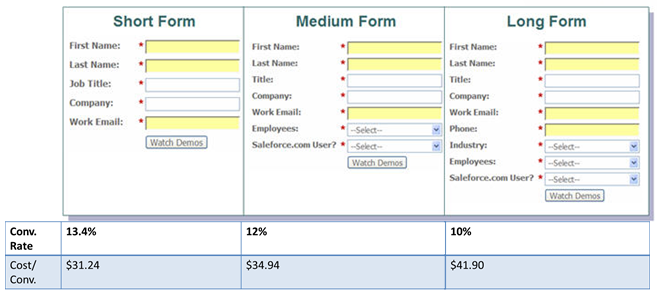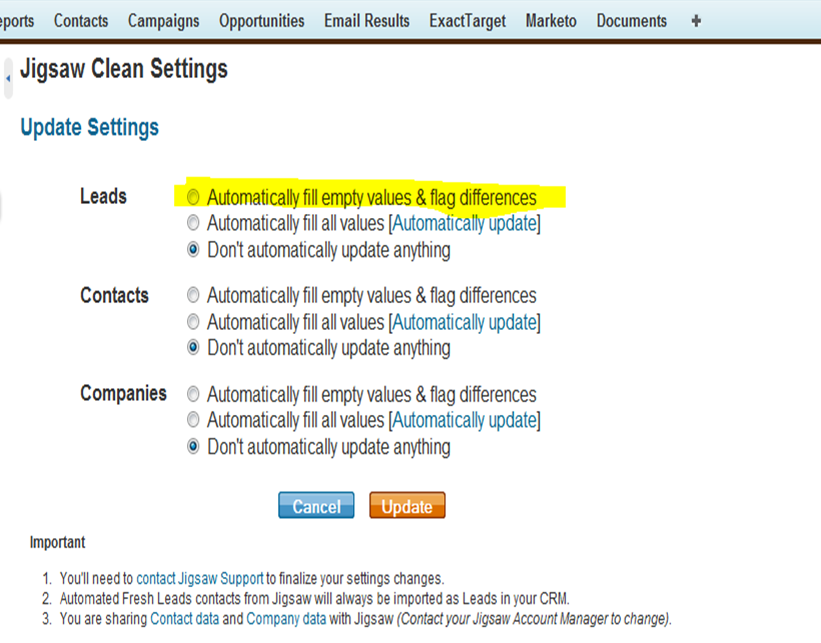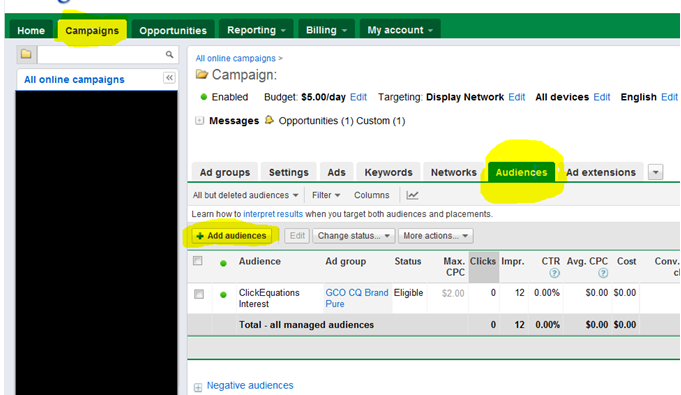This is a repost of my monthly column at Search Engine Watch.
When you’re dealing with a niche and high value product, competition for active buyers in paid search can be fierce. And expensive. Consider this example from enterprise security:
It’s basic economics: the smaller the universe and higher the value of click, the higher the CPC. If you’re in B2B or marketing another complex purchase, you likely need to be in front of this audience.
But, it’s not the only way to reach them. And you can pay 90 percent less.
Target Prospects When They’re Ready to Learn
Buying isn’t a linear process, but prospects generally go through some various phases of consideration before they purchase. The classic marketing AIDA model is a good way to think of the phases of search activity. It stands for Awareness, Interest, Desire, and Action and looks a little like this:
Somebody searching for “networks security software,” for example, is likely in the Action phase. Their search goals are focused around the execution of their purchase vs. research about the problem.
That same person would like search “how to improve network security” or “network security advice” well before they’re ready to buy. When prospects are in the awareness stage, they’re looking for education, not a sales pitch.
They’re also much cheaper to target.
I know this from personal experience. I manage the paid search campaign for ClickEquations, a SaaS platform to help people measure and manage their paid search advertising more effectively. As you can imagine, reaching Action searchers is pricey.
However, that same audience often searches for education about how to manage paid search efficiently. You can offer them a white paper. Educational clicks are 90 percent less expensive:
In addition to reducing your cost, you get the benefit of reaching customers before the competition and the ability to establish yourself as a thought leader.
Successfully targeting learners vs. buyers requires a different approach. Here are three tips for reach your prospects when they’re ready to learn.
Tip 1: Get Their Contact Information Without Asking For It
It’s common knowledge that adding form fields decreases conversion rate and increases your cost-per-conversion in most cases. But, how much do you really give up?
Jon Miller, co-founder and head of marketing at Marketo (disclosure: I’m a customer), wrote a really interesting article where he quantified the cost of adding more fields to his landing pages:
Conversion rate decreased 30 percent and cost went up $10 per lead! Not surprisingly, the most expensive field to add was phone number.
Asking for a phone number is often a sticking point for sales and marketing. Sales wants and needs the number to reach out to prospects, but, for early stage, educational content in particular, prospects are reluctant to disclose it and you miss a chance to establish a relationship.
As Miller points out in the article, however, there are other ways to get the data.
One solution to consider is Jigsaw Enterprise. It’s a Salesforce company that’s directly integrated into the platform. What distinguishes it from others is their data source: it’s crowdsourced as people enter contact information they have to credits for the info they want.
It’s also automatic. You can set up the system to auto-append information that isn’t associated with the record (which I recommend rather than over-writing something a prospect or sales rep has entered):
The data, which is appended every 12 hours, isn’t perfect or complete and the system isn’t priced for small businesses. But it does offer an automated way to increase conversions without losing all of the contact information your sales team needs.
Tip 2: Integrate Offline Conversion Tracking
Finding the keywords and setting up a landing page are relatively straightforward processes when you’re targeting learners. As you would expect, these people need to be nurtured and marketed to over time before they move into the Desire and Action phases.
That exacerbates an underlying issue with complex sales: long sales cycles and offline conversions. Not every educational prospect will be equally valuable. That is say: not every lead is qualified.
Ultimately, we want to adjust our marketing mix and paid search buys based on what closes, not just who flirts with us.
From a PPC perspective, however, that presents a challenge as we have to tie together three systems:
- Search engine data
- Our PPC tool
- Business outcomes from our customer relationship management (CRM) database
The trick to connecting the three systems together is the use of an external ID for each keyword. That unique key allows you connect front end data (clicks, cost, CPC) with online conversions (form submissions) and the later stage activity (opportunities, sales, retention).
A key can be any alphanumeric value, for example extid=18MQGH1MGKKQAG3T0.
You need four things to use this approach:
- System To Generate External IDs: This can be as simple as a spreadsheet or a more sophisticated platform that creates them automatically. Each key has to be specific to the keyword.
- Hidden Form Field to Capture External IDs: The IDs will be appended to your destination URL as a parameter. A hidden form field on your landing page will grab that ID from your URL. If you’ve ever setup a Salesforce form and added in a campaign or lead source variable, it’s the same approach.
- Method to Export External IDs with Values from a CRM: You need to be able to create a report or list that associates each external ID with a latent conversion and value from your system (e.g., “1 Opportunity” and “$500”).
- Tool to Connect Paid Search Data with External Conversions: Once you have an ID for a keyword and a value for that ID, you need technology to stitch together the two so you can measure, report, optimize, and bid on business outcomes.
Note that outcomes data, by its very nature, will be sparser than micro-conversions. You can optimize on earlier actions and do a biweekly or monthly review with the later stage data.
Tip 3: Retarget Prospects on the Display Network
It used to be that search marketers only got one, maybe two, chances to convert someone on a landing page before we lost them.
That changed with the introduction of retargeting, or remarketing as Google calls it. Briefly: remarketing allows you to show display ads only to an audience of people who have been to your site and exhibited some desirable behavior.
A classic business-to-consumer example is shopping cart recovery, or the targeting of buyers who added items to their shopping cart but who did not check out.
There is a parallel in B2B marketing. Prospects who visit your landing page, but don’t fill out your form are the most likely to convert from a display campaign and worth chasing with ads for a few days at least.
Setting up a remarketing campaign is relatively straightforward.
First, create what Google calls “Audience.” Set up a separate campaign for retargeting. Go to Campaigns > Audiences > Add Audience. If you don’t see the Audience tab, select the drop down arrow to add it.
In the “Create and manage lists” section, you’ll need to create three lists:
- People who visited your landing page.
- Those who visiting your thank you page (i.e., converted).
- A custom combination of list 1 and not list 2 (i.e., those who visited, but didn’t convert)
For each list (1 and 2), you’ll have a tag to put on your landing page (list 1) and your thank you page (list 2). This allows Google to cookie your audiences appropriately.
There is a lot of strategy in how to design and prioritize remarketing lists. I recommend you read Brad Geddes excellent article on the topic for more detail.
To be read for a remarketing campaign you’ll need:
- Banner ads to run on the display network. You’ll want text ads too, as some sites don’t accept banner ads.
- Separate campaigns for better budgeting and bidding.
- Proper tracking and attribution. Last click will only make it look like your retargeting campaign deserves all of the credit.
And We’re Only Just Getting Started…
Complex sales require marketing that supports how buyers purchase at every stage. Paid search is an integral part of that mix. If you’re locked out of active buyers because of CPCs or simply looking for a way to expand your PPC buy, targeting prospects when they need education is a great strategy.
To learn more about B2B paid search, I recommend you read The Buyersphere Project by Mediative (formerly Enquiro) and Ryan DeShazer’s recent column, “The Reinvention of B2B Paid Search.

